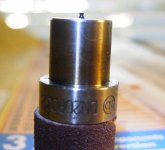SkyPup
Elite Member
- Joined
- Dec 3, 2003
- Messages
- 3,079
- Location
- North Central, Florida
- Tractor
- Kubota L-39 GST TLB, Kubota L3130GST, Massey 1030 HST, Kubota ZD-21 ProDecK, Two Euro VW TDIs
Compression pressure @ TDC in a modern Indirect Diesel Injection system like Kubota's when the engine is cold is around 450-500psi.
The inline fuel injection pump is providing pressure of around 3,000 psi to a pintle fuel injector nozzle which is approximately 6X higher pressure than the air inside the combustion chamber.
The compressed air in the combustion chamber temperature has been raised above the ignition temperature of #2 diesel fuel so that when the injector opens, the fuel immediately ignites as it is sprayed into the hot compressed air in the combustion chamber. The injector nozzle is situated inside the precombustion chamber leading into the combustion chamber as it is an indirect diesel injection system (IDI) as opposed to a direct injection (DI) system where the injector nozzle sprays directly into the combustion chamber on top of the piston crown.
The inline pump is mechanically driven and timed by the engine crankshaft, similar to the camsaft.
The timing of the injection event into the diesel engines 360* of crankshaft rotation is specifically important as the injector begins to spray after the intake and exhaust valves have been closed and the piston is still rising upwards. This crank shaft angle of injection is a very short period of time and the diesel fuel spray coming out of the injector into the combustion chamber must first mix and then ignite to provide power. The degrees of crankshaft rotation when the injection, mixture, and ignition of the fuel into the hot air is very short and the timeframe is also extremely short on the order of a couple of milliseconds.
In gasoline engine, the fuel and air are already mixed prior to entering the combustion chamber, however in diesel engines the fuel and air have to mix while inside the combustion chamber, prior to ignition.
Attached is a photograph of a Denso Pintle Injector nozzle.
The inline fuel injection pump is providing pressure of around 3,000 psi to a pintle fuel injector nozzle which is approximately 6X higher pressure than the air inside the combustion chamber.
The compressed air in the combustion chamber temperature has been raised above the ignition temperature of #2 diesel fuel so that when the injector opens, the fuel immediately ignites as it is sprayed into the hot compressed air in the combustion chamber. The injector nozzle is situated inside the precombustion chamber leading into the combustion chamber as it is an indirect diesel injection system (IDI) as opposed to a direct injection (DI) system where the injector nozzle sprays directly into the combustion chamber on top of the piston crown.
The inline pump is mechanically driven and timed by the engine crankshaft, similar to the camsaft.
The timing of the injection event into the diesel engines 360* of crankshaft rotation is specifically important as the injector begins to spray after the intake and exhaust valves have been closed and the piston is still rising upwards. This crank shaft angle of injection is a very short period of time and the diesel fuel spray coming out of the injector into the combustion chamber must first mix and then ignite to provide power. The degrees of crankshaft rotation when the injection, mixture, and ignition of the fuel into the hot air is very short and the timeframe is also extremely short on the order of a couple of milliseconds.
In gasoline engine, the fuel and air are already mixed prior to entering the combustion chamber, however in diesel engines the fuel and air have to mix while inside the combustion chamber, prior to ignition.
Attached is a photograph of a Denso Pintle Injector nozzle.
